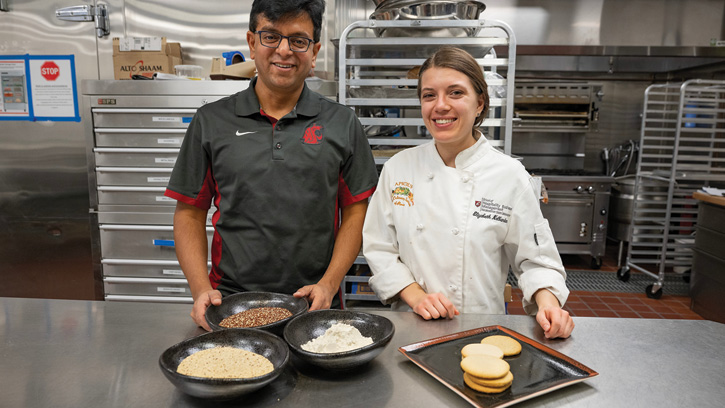Better Baking With Quinoa
Science Forward | RESEARCH
Before Girish Ganjyal joined the Washington State University faculty, he was working at a food company and received a call from a concerned grower. The grower had silos full of a quinoa harvest. The aim had been to sell it for use in ready-made, precooked quinoa salads. But the grower hadn’t performed a functionality test, and the quinoa variety was too sticky. It was, says Ganjyal, an associate professor and extension food processing specialist, “like a rock.”
Luckily, Ganjyal, an IFT member, helped the grower find another home for the quinoa—muffins. “That stickiness helped the muffins to stay soft,” he says.
Quinoa is an ancient grain grown in very specific conditions in South America. When the broader world learned of quinoa’s nutritional benefits about 15 years ago—its high protein, fiber, and zinc content—its popularity began to grow. However, initial enthusiasm waned, in part because of lack of knowledge of its product applications and partly because of availability. Food companies were trying to use whatever quinoa they could get, and they had a lot of product failures, Ganjyal says.
Seeking Optimal Strains
But plant breeders have been working on developing breeding strains that will flourish in North American growing conditions for good yield, disease resistance, and protein quality. That prompted Ganjyal to discuss functionality with Washington State’s Kevin Murphy, an associate professor in the Department of Crop and Soil Sciences. “Why don’t we consider the functionality now so that when we release the quinoa varieties into the market, we’re not finding it doesn’t fit any food product?” Ganjyal asked.
The scientists narrowed hundreds of breeding lines to 10 and recently published the results of their U.S. Department of Agriculture–funded research in the Journal of Food Science. Those 10 were selected because initial functionality tests showed they were good for baking, salads, and extruded products, says Ganjyal.
The researchers put the quinoa strains through their paces using a simple cookie batter made with shortening, sugar, salt, baking soda, and water. The quinoas were cooked for 20 minutes, drained, and cooled. They were then milled into flours.
The quinoa flours were combined with white all-purpose wheat flour at levels of 25%, 50%, and 75%, with one test using a 100% quinoa flour dough and one using 100% wheat flour as a control. The doughs were rolled to a 6 mm thickness, and cookies were cut and then baked for 10 minutes at 240°C. The researchers made three batches of 10 cookies with a goal of finding the level of quinoa that would maintain cookie quality as close to the control as possible—the spread ratio, thickness, and texture. They found two that were the most promising: strains WAQ7 and WAQ8.
A follow-up sensory analysis study showed that consumers didn’t notice when 25% of the flour was quinoa, and surprisingly, Ganjyal says, the tasters said that the 10% quinoa substitution cookies tasted even better than the control.
“We were able to see that about 25% replacement gives really good quality,” he adds. The goal was never to make a 100% quinoa cookie, he explains. Rather, it was to see if adding quinoa could help consumers eat more fiber.
Ganjyal coauthored a complementary study on quinoa’s extrusion characteristics in which various properties of quinoa flours, including density, expansion, and water absorption, were assessed. The researchers found that one breeding line is a good choice for puffy snack products, another for products like breakfast cereals.
“What I would say is for the industry now, there is this solid opportunity,” says Ganjyal. “If the companies now want to venture back in, they will have much better success for the longer term.”


